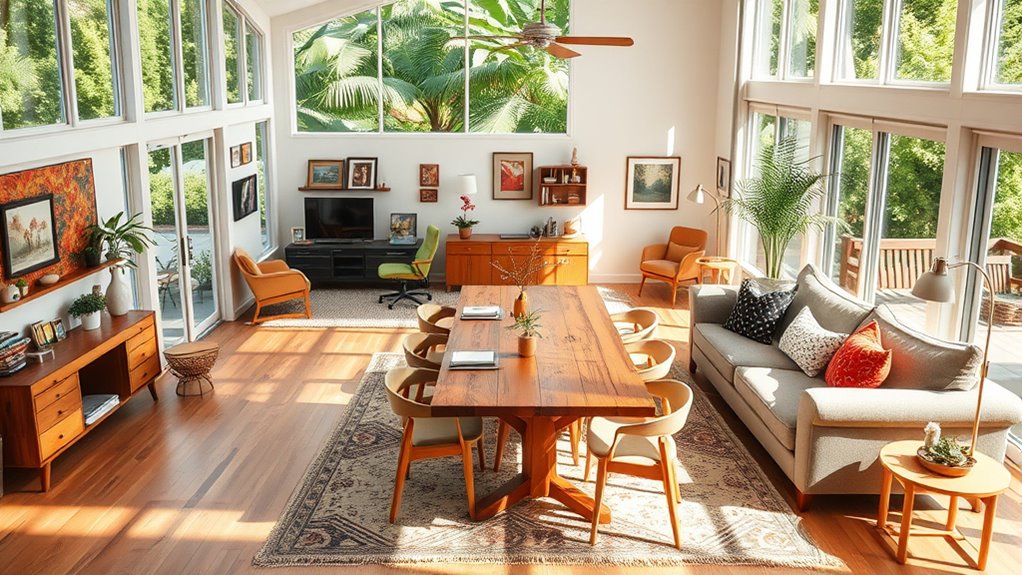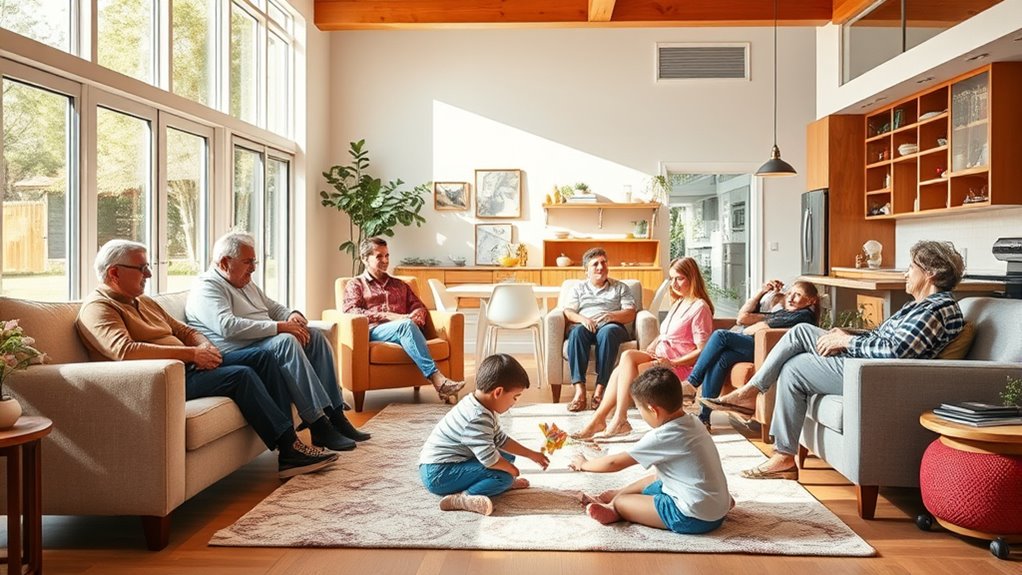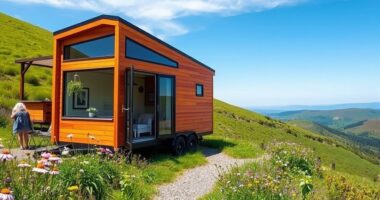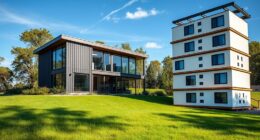When designing for multigenerational living, focus on balancing privacy with shared spaces. Incorporate private zones like separate bedrooms or suites, and consider soundproofing and discreet access points. Maximize every square foot with versatile furniture and clever storage solutions, while maintaining open areas for connection. Strategically place amenities like bathrooms and entrances to support independence and reduce conflicts. Explore more ideas to create a harmonious environment tailored to your family’s needs.
Key Takeaways
- Incorporate private zones like separate bedrooms or suites with soundproofing and discreet access for comfort.
- Maximize space with versatile furniture, built-in storage, and open floor plans to promote both privacy and togetherness.
- Place private quarters away from noisy areas, using vertical spaces and multi-purpose rooms for optimal layout.
- Design multiple bathrooms and separate entrances to enhance independence and reduce conflicts among family members.
- Balance shared communal spaces with private zones to foster connection while respecting individual privacy needs.

As multigenerational living becomes increasingly popular, designing a home that meets everyone’s needs is more important than ever. One of the biggest challenges you’ll face is balancing privacy considerations with shared spaces. To create a comfortable environment, you need to think carefully about how to give each generation their own sense of personal space while maintaining communal areas that foster connection. Start by defining private zones, such as separate bedrooms or suites, that allow family members to retreat and relax without feeling exposed. These spaces should be equipped with soundproofing or strategic placement to minimize noise disruptions, ensuring everyone has a peaceful refuge when needed. Incorporating bedroom design principles can help optimize these private areas for comfort and functionality.
Balancing privacy and shared space is essential in multigenerational homes for comfort and harmony.
Space optimization is essential to making multigenerational homes functional and comfortable. You’ll want to maximize every square foot by choosing versatile furniture and clever storage solutions. Consider furniture that can serve multiple purposes, like beds with built-in drawers or fold-away desks, which help conserve space and reduce clutter. Incorporate built-in shelving or under-stair storage to keep communal areas tidy, freeing up room for shared activities. Open floor plans can be advantageous, fostering a sense of togetherness, but you should also include designated zones for quieter, more private activities. Using partitions or movable screens can help define these spaces temporarily, giving family members control over their environment.
Another key aspect of space optimization involves thoughtful layout planning. When designing or renovating, place private quarters away from noisy common areas like the kitchen or living room. This minimizes disturbances and creates a peaceful atmosphere for those who need rest or focus. If your home is limited in size, vertical space can be your best friend—adding lofted bedrooms, mezzanines, or multi-level layouts can expand usable space without enlarging the footprint. Additionally, multi-purpose rooms that serve as guest bedrooms, offices, or hobby areas help you adapt to changing needs over time.
Privacy considerations also extend to amenities like bathrooms and entrances. Having multiple bathrooms or ensuite options reduces wait times and potential conflicts. Separate entrances or discreet access points for different family members can further enhance privacy, especially for adult children or elderly relatives. When planning these features, think about traffic flow and how residents will move through the space to avoid bottlenecks or privacy breaches.
Frequently Asked Questions
How Can I Ensure Privacy for All Generations in Shared Spaces?
To address privacy concerns in shared spaces, you can implement effective space division strategies. Use room dividers, curtains, or furniture placement to create distinct areas for each generation. Incorporate soundproofing or rugs to reduce noise transfer. Encourage clear boundaries and designate private zones, ensuring everyone feels comfortable. These measures help maintain individual privacy while fostering harmony in multigenerational living, making shared spaces functional and respectful for all.
What Are Cost-Effective Solutions for Multigenerational Home Renovations?
Looking for cost-effective solutions for multigenerational home renovations? You can focus on budget-friendly upgrades like repainting walls with neutral colors, installing new fixtures, or adding temporary privacy screens. DIY renovation tips, such as building simple storage solutions or updating hardware, save money and boost functionality. These approaches help you create comfortable, adaptable spaces without overspending, ensuring everyone’s needs are met while keeping costs manageable.
How Do I Balance Modern and Traditional Interior Design Styles?
Ever wonder how to master the delicate dance of decor blending? It’s about finding the right style contrast that keeps your space cohesive yet interesting. You balance modern and traditional elements by highlighting their differences—perhaps sleek furniture with classic accents. Use neutral tones to unite diverse styles, and add statement pieces for personality. With a thoughtful approach, you create a space that feels both timeless and fresh, enthralling everyone who enters.
What Safety Features Are Essential for Older Adults in Multigenerational Homes?
You should prioritize safety features like home automation systems that allow you to monitor and control lighting, locks, and thermostats easily. Install grab bars and non-slip flooring in bathrooms, and keep emergency preparedness kits accessible. These features help older adults feel secure and independent while ensuring quick responses during emergencies. Incorporating smart technology makes daily routines safer, giving everyone peace of mind in your multigenerational home.
How Can I Optimize Outdoor Spaces for Different Age Groups?
Imagine your outdoor space as a vibrant tapestry woven with diverse needs. To optimize it for all age groups, focus on thoughtful landscape design that balances play areas, cozy nooks, and open spaces. Use versatile outdoor furniture that invites relaxation and activity. Incorporate shaded zones and safe pathways, creating a welcoming haven where every generation can gather, share stories, and enjoy nature’s embrace together.
Conclusion
As you weave together spaces for every generation, you’re crafting a tapestry of togetherness and independence. Think of your home as a welcoming garden, blooming with adaptable nooks and shared havens that grow with your family’s needs. With each thoughtful design choice, you’re planting seeds of harmony and comfort, creating a sanctuary where generations intertwine like branches on a sturdy tree. Embrace these trends and tips—your home will flourish as a vibrant, multigenerational haven.









